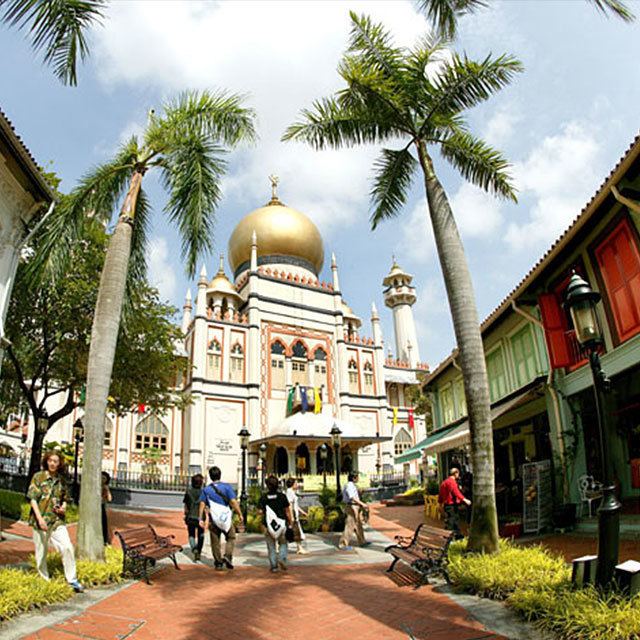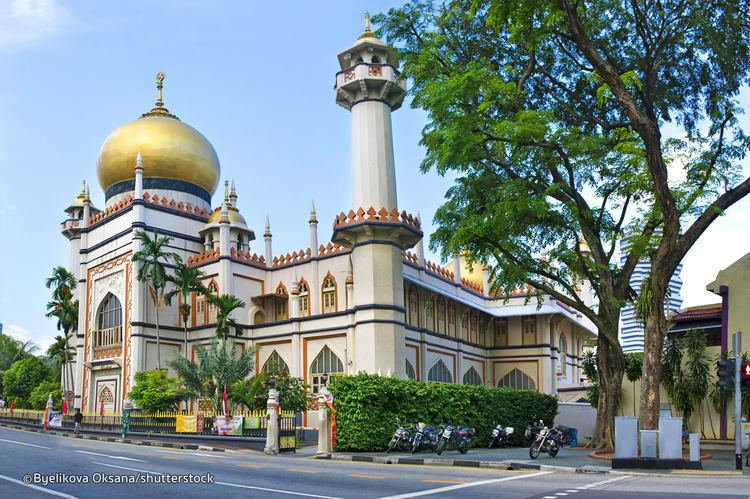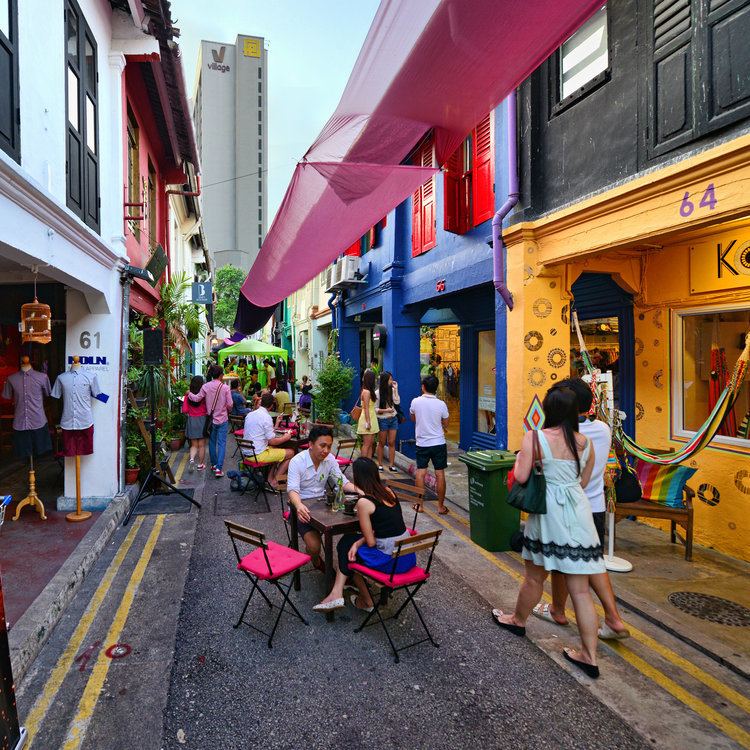 | ||
Kampong glam and sultan mosque in singapore entersingapore info
Kampong Glam (Malay: Kampong Gelam; Jawi script: كامڤوڠ ڬلم ; Chinese: 甘榜格南; pinyin: Gānbǎnggénán; Tamil: கம்ப்பொங் கிலாம்) is a neighbourhood in Singapore. It is located north of the Singapore River, in the planning area of Rochor.
Contents
- Kampong glam and sultan mosque in singapore entersingapore info
- Present
- Political history
- Additional reading
- References
The name of the area is thought to be derived from the cajeput tree, called "gelam" in Malay. "Kampong" (modern spelling "kampung") simply means "village".
Prior to colonisation by the British in 1819, the area was home to the Malay aristocracy of Singapore. It became prominent and more populous after the signing of a treaty between the British East India Company, Sultan Hussein Shah of Johor and Temenggong Abdul Rahman in 1819. The company was given the right to set up a trading post in Singapore under this treaty.

During the colony's early history, under the Raffles Plan of 1822, the settlement was divided according to different ethnic groups which included European Town, Chinese, Chulia, Arab and Bugis kampongs. Kampong Glam was designated for the Sultan and his household, as well as the Malay and Arab communities, many of whom were merchants. It was situated east of what was then the European Town.

While the Temenggong and his followers settled in Telok Blangah, Sultan Hussein, his family and followers settled in Kampong Glam. In return, the Sultan was given large areas of land for residential use in Kampong Glam under the treaty. The land was allocated to the Malays and other Muslim immigrants to Singapore, including the Malays from Malacca, the Riau Islands and Sumatra in Indonesia.
The second half of the nineteenth century saw the rapid growth of immigrant communities in Kampong Glam, initially from Sumatra, and later from other parts of Indonesia and Malaya. This resulted in the setting up of different kampongs, like Kampong Malacca, Kampong Java and Kampong Bugis. There were also a small but successful Arab community of traders in the area.
In the early twentieth century, commercial activities in Kampong Glam expanded as new shop houses and residential buildings were built. A multi-ethnic community soon developed there, comprising not only Malays and Arabs but also the Chinese and Indians.
Later, due to an expansion of commercial activities and an increase in immigrant settlers in Kampong Glam, the Arabs moved to areas like Joo Chiat, Tanglin and Bukit Tunggal (the stretch of Dunearn Road near the junction of Balmoral Road and Chancery Lane, near Anglo-Chinese School (Barker Road) today, was called Tunggal Road).
By the early 1920s, many Malays also moved out to designated resettlement areas in Geylang Serai and Kampong Eunos.
Present
Today, Kampong Glam still retains strong ties to the Native-Malay and Muslim community, and has sometimes been termed the "Muslim Quarter" due to its history. The Muslim population still remains a significant presence in Kampong Glam, especially in Bussorah Street. The area remains a centre for Muslim activities and the Sultan Mosque remains a major landmark and congregation point for Singapore Muslims.
Like Little India and Chinatown, Kampong Glam has been restored, refurbished and new life breathed into it, bringing back the former colour and vibrancy of the area. Rows of conserved shophouses can be found in Arab Street, Baghdad Street and Bussorah Street. Many of these shophouses have new tenants such as design and IT firms, art galleries, crafts and curios shops, food caterers and restaurants. They blend in with traditional businesses like textile and carpet shops, blacksmiths and shops selling religious items used by Muslims. It is also an area of good restaurants, from Malaysian coffee shops and bakeries to fine modern European dining, like Le Pont De Vie.
On 16 December 2006, a fire broke out at four shophouses at Sultan Gate at 2145 (SST) with the four shophouses destroyed by the fire. It nearly spread to nearby food and beverage outlets in the vicinity. Of the four shophouses destroyed, two were vacant, one was a blacksmith shop and the other a shoe shop. Firefighters controlled the fire by surrounding it as it spread through the roof. According to eyewitnesses, the fire started from the second floor of the blacksmith shop. The blacksmith shop is one of the oldest type of shophouses in Singapore which was used for education tours.
Political history
Since the 1959 general elections, Kampong Glam is a division of its own called Kampong Glam Single Member Constituency where the Member of Parliament seat was held by Former Deputy Prime Minister S. Rajaratnam until 1988 when Loh Meng See took over and served until 2006.
However, after the 1991 general elections, Kampong Glam SMC along with several neighbouring wards were absorbed into the bigger Kampong Glam Group Representation Constituency which existed for only one term and the ruling party People's Action Party had won the seats on the nomination day itself.
Subsequently in the 1997 general elections, Kampong Glam GRC was disbanded and Kampong Glam's electoral division was reverted to Kampong Glam SMC with single-member representation that lasted until the 2001 general election whereby the redrawing of electoral boundaries saw it absorbed into Jalan Besar Group Representation Constituency, which includes parts of the Downtown Core.
Loh has since retired from politics by 2006 general election and the current MP is Denise Phua who represents Jalan Besar GRC. In the 2011 general elections, Jalan Besar GRC was dissolved and became part of the newly created Moulmein-Kallang Group Representation Constituency; Edwin Tong has since taken over the helm. But in 2015, Jalan Besar GRC was revived and both Denise Phua and Dr Yaacob Ibrahim took over the helm of the entire GRC and Edwin Tong was transferred to Marine Parade GRC's Joo Chiat ward.
